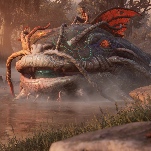An All-Time Cast Makes Dragon Age: The Veilguard Stand Out

It’s rare that I’d stop in my tracks to hear NPC characters chat with each other. But that’s what Dragon Age: The Veilguard made me do. I loved hearing the banter between the Elven Veil Jumper Bellara Lutare and necromancer Emmrich Volkarin about their interest in magic as I just casually ran around an area trying to solve a light puzzle to unlock a door.
The Veilguard has the best cast in the series so far, and that’s what kept my attention to the very end. While its action-oriented combat feels like a step back in some aspects from previous games, it’s still fun to play. And its presentation and visuals make it an incredibly smooth ride from start to finish.
The story follows Rook, an agent hired to track down Solas and stop him from tearing down the Veil, a barrier that keeps hostile beings from another dimension from entering the world. When events go catastrophically wrong, Rook now has to stop two ancient gods, Elgar’nan and Ghilan’nain, who were accidentally released from their prisons from unleashing their own kind of hell.
It’s an explosive setup that immediately lays out the stakes, and the story that follows is surprisingly well paced. It has three distinct acts and the end of each act leaves players with a sense of accomplishment as it feels like Rook’s crew, despite being made up of mortals, is one step closer to overcoming these seemingly immortal gods.
While The Veilguard has a solid story, it’s the characters that really help uplift it, and there was a sense of camaraderie I haven’t felt since playing Mass Effect 2. For example, Rook recruits Taash, a specialized dragon hunter and Davrin, a Grey Warden. The two gods enslaved powerful dragons and inflicted them with Blight, a sort of spiritual disease that corrupts them and turns them into archdemons; it’s up to both Taash and Davrin’s expertise to help take them down. The former has experience hunting dragons while the latter is able to purify them of the Blight to prevent them from respawning. It’s a smart kind of synergy that makes every companion feel like they have an active role to play in the story.

While the main story itself isn’t that long, the game has an incredible amount of side quests for you to tackle. And they’re not shallow ones either, and are very well worth your time. There are specific quests that you can partake in with each of your companions to learn more about their backstories, as well as some typical world-building ones. Emmrich ended up being my favorite companion. He works with spirits and has a comedic skeleton assistant named Manfred. Even though a necromancer seems scary, his lighthearted approach to the subject and kind demeanor made for a compelling string of side quests about his traumatic past and topic of mortality.
I played the three previous games to prepare for The Veilguard, and I can confidently say that the cast’s rich diversity of both in-game cultures and inspirations makes it stand out. Taash is a Qunari, a race of large humanoids. Not only that, but she’s a female Qunari, which gives her a different perspective from many of the Qunari we’ve seen so far, who have mostly been male. It also seems like developer BioWare has taken real-world inspirations for its characters as well. The group’s hired assassin, Lucanis Dellamorte, has Italian-inspired roots while Bellara’s Eastern Asian influence can be seen through her own magical mythology. While previous Dragon Age games had some diversity in its cast, The Veilguard walks the extra mile and creates a distinctively unique cast of companions in both appearances and backstories
-

-

-

-

-

-

-

-

-

-

-

-

-

-

-

-

-

-

-

-

-

-

-

-

-

-

-

-

-

-

-

-

-

-

-

-

-

-

-

-









































